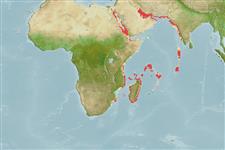Teleostei (teleosts) >
Callionymiformes (Dragonets) >
Callionymidae (Dragonets)
Etymology: Synchiropus: Greek, syn, symphysis = grown together + Greek, cheir = hand + Greek, pous = foot (Ref. 45335).
More on author: Regan.
Environment: milieu / climate zone / depth range / distribution range
Ecology
Marine; demersal; depth range 34 - 68 m (Ref. 96610). Tropical
Indo-West Pacific: Red Sea (Gulf of Suez); Gulf of Aden; Somalia; Seychelles; Maldives; East Coral Sea (Chesterfield Islands; Banc du Sable); New Caledonia (Grande Terre Group). Mediterranean Sea (Turkey, as Lessepsian migrant);
Size / Weight / Age
Maturity: Lm ? range ? - ? cm
Max length : 3.8 cm SL male/unsexed; (Ref. 11303)
Benthic fishes found on sandy or muddy substrates, among weeds and in coral reefs from tide pools and the surf zone (Ref. 96610).
Life cycle and mating behavior
Maturity | Reproduction | Spawning | Eggs | Fecundity | Larvae
Fricke, R., 2016. Synchiropus novaehiberniensis, a new species of dragonet from New Ireland, Papua New Guinea, western Pacific Ocean, with a review of subgenus Synchiropus (Neosynchiropus) and description of a new subgenus (Teleostei: Callionymidae). J. Nat. Hist. (Ref. 111072)
IUCN Red List Status (Ref. 130435: Version 2024-1)
Threat to humans
Harmless
Human uses
Tools
Special reports
Download XML
Internet sources
Estimates based on models
Preferred temperature (Ref.
123201): 23.3 - 28.2, mean 26.1 °C (based on 22 cells).
Phylogenetic diversity index (Ref.
82804): PD
50 = 0.5000 [Uniqueness, from 0.5 = low to 2.0 = high].
Bayesian length-weight: a=0.00794 (0.00362 - 0.01742), b=2.81 (2.63 - 2.99), in cm total length, based on LWR estimates for this (Sub)family-body shape (Ref.
93245).
Trophic level (Ref.
69278): 3.2 ±0.4 se; based on size and trophs of closest relatives
Resilience (Ref.
120179): High, minimum population doubling time less than 15 months (Preliminary K or Fecundity.).
Fishing Vulnerability (Ref.
59153): Low vulnerability (10 of 100).
